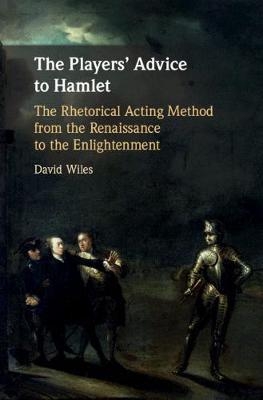
The Players' Advice to Hamlet
The Rhetorical Acting Method from the Renaissance to the Enlightenment
Seiten
2020
Cambridge University Press (Verlag)
978-1-108-49887-6 (ISBN)
Cambridge University Press (Verlag)
978-1-108-49887-6 (ISBN)
Explores the art of acting in Europe between the sixteenth and eighteenth centuries, demonstrating how stage acting was understood as a branch of rhetoric. This book distinguishes the methods of professionals from the theories of intellectual amateurs, and argues that the present has much to learn from premodern debates.
Hamlet is a characteristic intellectual more inclined to lecture actors about their craft than listen to them, and is a precursor of Enlightenment figures like Diderot and Lessing. This book is a quest for the voice of early professional actors, drawing on English, French and other European sources to distinguish the methods of professionals from the theories of intellectual amateurs. David Wiles challenges the orthodoxy that all serious discussion of acting began with Stanislavski, and outlines the comprehensive but fluid classical system of acting which was for some three hundred years its predecessor. He reveals premodern acting as a branch of rhetoric, which took from antiquity a vocabulary for conversations about the relationship of mind and body, inside and outside, voice and movement. Wiles demonstrates that Roman rhetoric provided the bones of both a resilient theatrical system and a physical art that retains its relevance for the post-Stanislavskian performer.
Hamlet is a characteristic intellectual more inclined to lecture actors about their craft than listen to them, and is a precursor of Enlightenment figures like Diderot and Lessing. This book is a quest for the voice of early professional actors, drawing on English, French and other European sources to distinguish the methods of professionals from the theories of intellectual amateurs. David Wiles challenges the orthodoxy that all serious discussion of acting began with Stanislavski, and outlines the comprehensive but fluid classical system of acting which was for some three hundred years its predecessor. He reveals premodern acting as a branch of rhetoric, which took from antiquity a vocabulary for conversations about the relationship of mind and body, inside and outside, voice and movement. Wiles demonstrates that Roman rhetoric provided the bones of both a resilient theatrical system and a physical art that retains its relevance for the post-Stanislavskian performer.
David Wiles is Emeritus Professor of Drama at the University of Exeter. A British theatre historian, he specialises in classical and early modern theatre and has spent his career in departments of drama, where his teaching has always engaged with practice. His research interests include performance space and time, mask, acting and citizenship. This is his eighth book for Cambridge University Press.
Introduction; 1. Hamlet's advice to the players; 2. Rhetorical performance in antiquity; 3. Acting, preaching and oratory in the sixteenth century; 4. Baroque acting; 5. Actors and intellectuals in the Enlightenment era; 6. Emotion; 7. Declamation; 8. Gesture; 9. Training.
| Erscheinungsdatum | 06.02.2020 |
|---|---|
| Zusatzinfo | Worked examples or Exercises; 18 Halftones, black and white |
| Verlagsort | Cambridge |
| Sprache | englisch |
| Maße | 160 x 235 mm |
| Gewicht | 740 g |
| Themenwelt | Kunst / Musik / Theater ► Theater / Ballett |
| Geisteswissenschaften ► Sprach- / Literaturwissenschaft ► Anglistik / Amerikanistik | |
| Geisteswissenschaften ► Sprach- / Literaturwissenschaft ► Literaturwissenschaft | |
| ISBN-10 | 1-108-49887-6 / 1108498876 |
| ISBN-13 | 978-1-108-49887-6 / 9781108498876 |
| Zustand | Neuware |
| Haben Sie eine Frage zum Produkt? |
Mehr entdecken
aus dem Bereich
aus dem Bereich
Poetik eines sozialen Urteils
Buch | Hardcover (2023)
De Gruyter (Verlag)
CHF 83,90
Buch | Softcover (2024)
belleville (Verlag)
CHF 27,95


